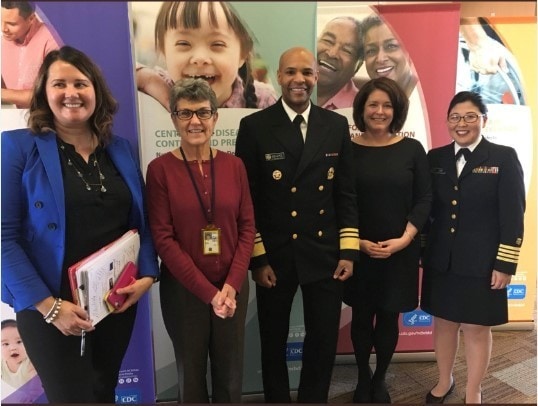The Bloodline Newsletter: Summer 2018

Mission: To improve quality of life, life expectancy, and health among people living with sickle cell disease (SCD).
Summer 2018
Communications Corner

- Stepping Up: A 2-Part Video Series for Teenagers & Young Adults with SCD: features Kevin and Calvanay, two young adults with SCD, who share their thoughts about transition, how it has affected them, and how they’ve overcome challenges.
- SCDC Program Fact Sheet: shows how the SCDC program is helping to improve the lives of people with SCD.
- SCD Disparities Fact Sheet: focuses on a general audience to raise awareness about health outcomes and health resource disparities among people with SCD.
- CDC’s Sickle Cell Disease Surveillance History Fact Sheet: provides information about CDC’s work in monitoring SCD since 2010, specifically the Registry and Surveillance System for Hemoglobinopathies (RuSH), Public Health Research, Epidemiology, and Surveillance for Hemoglobinopathies (PHRESH), and the SCDC program.
- CDC’s “My Story” Series: new stories (“Courtney Stinnett Story” and “Johnson Family Story”) about managing SCD and the link between sickle cell trait and renal medullary carcinoma.
- A column in Georgia State University’s student newspaper about the importance of minority blood donation for patients with SCD.
- A column in Atlanta’s SaportaReport about SCDC efforts to leverage data to improve the lives of Georgians with SCD or thalassemia.
In the Community
- California SCDC is providing leadership and technical assistance to an initiative to draft a state plan for SCD. The plan aims to address the gaps in care and services and also poor health outcomes of people living with SCD in California by communicating specific, achievable objectives to state and federal agencies, healthcare systems, insurers, and other stakeholders. Over 50 advocates, CBOs, healthcare providers, researchers, and administrators gathered in Sacramento in late January to kick off the initiative. Work groups from the gathering have met biweekly since the kick-off.
Up-to-Data
- SCDC data were used to target Georgia hospitals that transfuse a high number of patients with SCD for consults to improve blood bank practices.
- California’s SCDC program efforts to collect clinical data from centers of care for SCD continue to pick up steam. The program has received preliminary data from three collaborators (through 2016) and have several contracts either pending or being developed. The program has also received up-to-date (through 2017) data from the state’s Newborn Screening program on SCD births. Medicaid data from 2016 is anticipated by late April 2018. In addition, a request for one year of Medicare data to explore the data’s utility is in the works.
Presentations and Meetings

From left to right: Sascha Chaney, Dr. Coleen Boyle, Dr. Jerome Adams, Dr. Mary Hulihan, Dr. Karon Abe; Source: U.S. Surgeon General Jerome Adams
- Presented “Health Equity for Sickle Cell Disease” at Mercer University School of Public Health to encourage Masters level students to think about health equity beyond the typical variables of race, gender, age, and socioeconomic status.
- Met with the U.S. Surgeon General, Dr. Jerome Adams, to discuss SCD and the SCDC program. The meeting resulted in strategies aimed at leveraging resources and partnerships throughout the Federal government to educate people in the U.S. about SCD and to improve health outcomes.
- Presented “Leveraging Georgia’s Sickle Cell Surveillance Data” at Emory University School of Public Health’s Maternal and Child Health Epidemiology course to educate Public Health students about ways surveillance data can be used to better understand chronic diseases like SCD.
- Presented “An Overview of CDC’s SCD Surveillance” at the Texas Sickle Cell Coalition’s meeting to share the benefits of state-wide SCD surveillance, the ways that SCDC data are being utilized, and the steps necessary to begin a surveillance system.
- Met with Office of the Assistant Secretary for Health, Regional Health Administrator, Region IV about SCDC and provided material for her keynote address at the Farm, Home, and Minister’s Conference at Fort Valley State University as well as her presentation to State Health Officers.
- Met with the Georgia State Department of Public Health, Refugee Health Office to better understand the course of clinical care for refugees with SCD arriving in the United States, and to determine how the SCDC program could be better used to benefit this population.
- Met with Dr. Bret Giroir, HHS Assistant Secretary of Health, to provide a briefing on SCDC activities and to discuss how the work can continue to benefit other agencies across HHS.
In the News
- Why You Don’t Hear Much About Sickle Cell Anymore
https://the1a.org/shows/2018-02-05/why-you-dont-hear-much-about-sickle-cell-anymore - Sickle Cell Patients Endure Discrimination, Poor Care, And Shortened Lives
https://www.npr.org/sections/health-shots/2017/11/04/561654823/sickle-cell-patients-endure-discrimination-poor-care-and-shortened-lives - Stem Cell Treatment Offers Hope for Sickle Cell Anemia Cure
https://www.healthline.com/health-news/stem-cell-treatment-offers-hope-for-sickle-cell-anemia-cure - Breakthrough CRISPR Gene Editing Trial Set to Begin This Year
http://www.newsweek.com/crispr-therapeutics-crispr-cas9-gene-editing-beta-thalassaemia-887051 - Communities of Color Struggling But Ignored In The Opioid Crisis
https://www.opb.org/news/article/communities-of-color-struggling-but-ignored-in-the-opioid-crisis/ - First R.I. Black Film Festival Debuts
http://www.providencejournal.com/entertainmentlife/20180412/first-ri-black-film-festival-debuts
Announcements

- Webinar: “Sickle Cell Disease and Health Disparities.”Tuesday, July 31, 2018Presenter: Dr. Wally Smith, Professor of Internal Medicine and Scientific Director of the Virginia Commonwealth University Center on Health Disparities.Join the email list to receive announcements about upcoming webinars.Find archived webinars here!
Contact
For any questions about the SCDC program, contact Mary Hulihan (ibx5@cdc.gov) or Mandip Kaur (wvx6@cdc.gov).
If you are not currently a subscriber, click the subscribe button below to get SCDC program updates.

